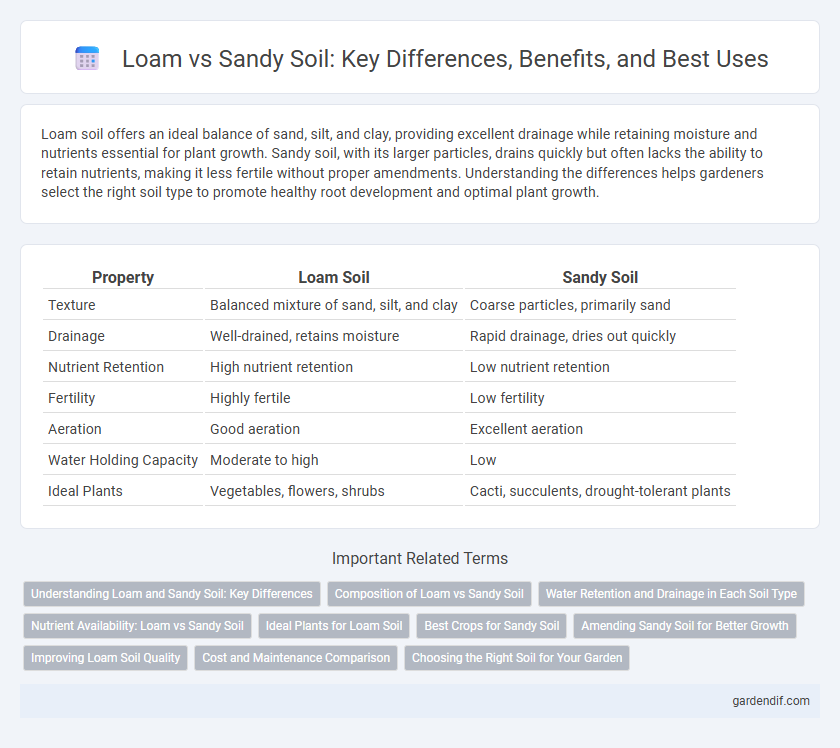
Loam vs Sandy Soil Illustration
Loam soil offers an ideal balance of sand, silt, and clay, providing excellent drainage while retaining moisture and nutrients essential for plant growth. Sandy soil, with its larger particles, drains quickly but often lacks the ability to retain nutrients, making it less fertile without proper amendments. Understanding the differences helps gardeners select the right soil type to promote healthy root development and optimal plant growth.
Table of Comparison
| Property | Loam Soil | Sandy Soil |
|---|---|---|
| Texture | Balanced mixture of sand, silt, and clay | Coarse particles, primarily sand |
| Drainage | Well-drained, retains moisture | Rapid drainage, dries out quickly |
| Nutrient Retention | High nutrient retention | Low nutrient retention |
| Fertility | Highly fertile | Low fertility |
| Aeration | Good aeration | Excellent aeration |
| Water Holding Capacity | Moderate to high | Low |
| Ideal Plants | Vegetables, flowers, shrubs | Cacti, succulents, drought-tolerant plants |
Understanding Loam and Sandy Soil: Key Differences
Loam soil is a balanced mixture of sand, silt, and clay particles, offering optimal drainage, nutrient retention, and aeration for plant growth. Sandy soil consists predominantly of large sand particles that promote quick drainage but often lack sufficient nutrients and water retention. Understanding these differences is crucial for selecting the appropriate soil type to enhance crop yield and garden health.
Composition of Loam vs Sandy Soil
Loam soil is composed of approximately 40% sand, 40% silt, and 20% clay, providing balanced texture and optimal nutrient retention. Sandy soil primarily consists of over 85% sand particles, resulting in larger pores and faster drainage but lower water and nutrient retention. The higher silt and clay content in loam enhances soil structure and fertility compared to the coarse, gritty texture of sandy soil.
Water Retention and Drainage in Each Soil Type
Loam soil balances water retention and drainage by combining sand, silt, and clay particles, allowing it to hold moisture efficiently while preventing waterlogging. Sandy soil has larger particles, which create larger pores that facilitate rapid drainage but reduce its ability to retain water. The high permeability of sandy soil often requires more frequent irrigation compared to the moderate water-holding capacity of loam.
Nutrient Availability: Loam vs Sandy Soil
Loam soil offers high nutrient availability due to its balanced mixture of sand, silt, and clay, which retains essential minerals and organic matter more effectively than sandy soil. Sandy soil has low nutrient-holding capacity because its large particle size allows minerals to leach away quickly, reducing the concentration of nutrients accessible to plants. This difference influences plant growth, making loam soil more fertile and suitable for a wide range of crops compared to sandy soil.
Ideal Plants for Loam Soil
Loam soil supports ideal growth for plants such as tomatoes, carrots, lettuce, and beans due to its balanced mixture of sand, silt, and clay that ensures nutrient retention and proper drainage. Its rich organic matter content promotes root development and moisture retention, making it suitable for a wide range of vegetables, flowers, and fruit trees. Unlike sandy soil, loam maintains consistent moisture levels, which benefits plants requiring moderate water without risk of waterlogging.
Best Crops for Sandy Soil
Sandy soil, characterized by its large particle size and excellent drainage, is ideal for growing root vegetables such as carrots, potatoes, and radishes that require loose, well-aerated soil to prevent waterlogging. Crops like watermelon, peanuts, and asparagus thrive in sandy soil due to its ability to warm quickly and its low nutrient retention, which can be managed with proper fertilization. The best crops for sandy soil emphasize drought tolerance and adaptability to nutrient leaching, making these plant types optimal for such soil conditions.
Amending Sandy Soil for Better Growth
Amending sandy soil for better plant growth involves adding organic matter such as compost, peat moss, or well-rotted manure to improve water retention and nutrient availability. Incorporating materials like vermiculite or coconut coir enhances moisture-holding capacity while promoting aeration and root development. Regular mulching and the use of slow-release fertilizers further support sustained nutrient supply and soil structure improvement in sandy soil environments.
Improving Loam Soil Quality
Enhancing loam soil quality involves increasing organic matter through compost or manure to boost nutrient content and moisture retention. Regularly incorporating cover crops like clover or legumes enriches soil structure and promotes beneficial microbial activity. Maintaining proper pH levels between 6.0 and 6.8 supports optimal nutrient availability and plant growth in loam soil.
Cost and Maintenance Comparison
Loam soil, composed of balanced sand, silt, and clay, generally requires less frequent fertilization and watering, reducing long-term maintenance costs compared to sandy soil. Sandy soil's larger particles lead to faster drainage but necessitate higher investments in irrigation systems and soil amendments to retain nutrients. Initial costs for loam soil may be higher due to sourcing and transport, but its nutrient retention and low maintenance needs ultimately provide better cost efficiency for gardening and agriculture.
Choosing the Right Soil for Your Garden
Loam soil offers an ideal balance of sand, silt, and clay, promoting excellent drainage and nutrient retention essential for healthy plant growth. Sandy soil drains quickly but often lacks nutrients, requiring more frequent fertilization and irrigation to support garden plants effectively. Selecting loam soil enhances root development and moisture retention, making it the preferred choice for most garden environments.
Loam vs Sandy Soil Infographic

 gardendif.com
gardendif.com